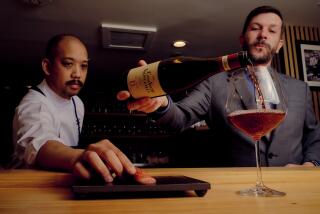Wine tastings: All you need to do it yourself
- Share via
WITH the following accessories on the table, your tasting group will be able to swirl, sniff and sip like pros.
Wine glasses. Four glasses each is ideal. Six is OK. Any more is confusing for novice tasters who are just learning to compare and contrast wines. If you have more wines than glasses, taste them in groups (“flights”) and if desired, rinse the glasses in between.Glass stemware is a good choice. Just make sure the glasses are clean with no soap residue. The bowl of the wine glass should be deep enough to allow the wine’s aromas to develop, with space left to stick your nose in for a good whiff. Four inches deep is optimal.
Spit cups. Overconsumption of alcohol can be an issue. The pros sip, swish the wine around their mouths, and then spit delicately into some sort of spit bucket -- large paper cups work great. Your friends will appreciate having the option.
Lots of water. Water cleanses your palate between wines. Set a water glass and a pitcher (or a bottle of still water) at each place. If you are tasting more than one flight of wine, you may want water to rinse out your glasses as well.
Bread or crackers. An occasional piece of bland bread or a cracker can revive your taste buds.
Dump buckets. Flower vases, ice buckets and beer pitchers all make great receptacles for emptying your spit cups and rinse water. One bucket for every two people is enough.
Table and tablecloth. Seat your friends around tables with plenty of elbow room. To compare the wines’ colors, you need to look at them against something white, so cover the table with a white cloth. If the thought of red wine stains makes you nervous, a disposable tablecloth is fine.
Napkins. Water and wine are guaranteed to spill.
Aluminum foil or paper wine bags. To disguise bottles for a blind tasting, wrap them in foil or put them in paper wine bags, taping the bags around the necks. Number them with marking pens.
Paper and pens. Print out lists of the wines to be tasted, or provide blank sheets for notes so participants can record favorites for future purchase.
Wine atlas. A decent wine atlas helps avoid bickering over wine regions and varietal attributes.
-- Corie Brown
More to Read
Eat your way across L.A.
Get our weekly Tasting Notes newsletter for reviews, news and more.
You may occasionally receive promotional content from the Los Angeles Times.










